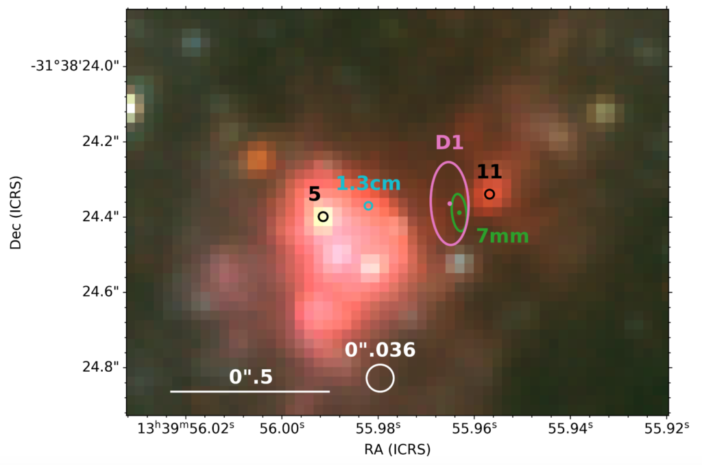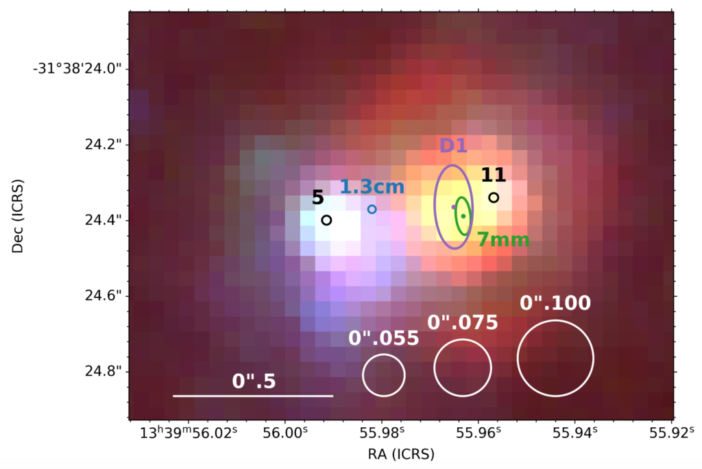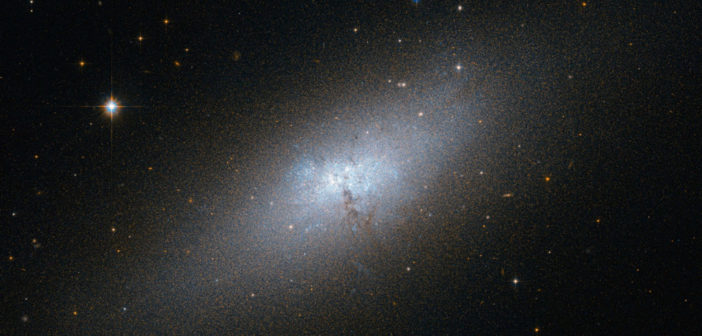Editor’s note: Astrobites is a graduate-student-run organization that digests astrophysical literature for undergraduate students. As part of the partnership between the AAS and astrobites, we occasionally repost astrobites content here at AAS Nova. We hope you enjoy this post from astrobites; the original can be viewed at astrobites.org.
Title: The Three Young Nuclear Super Star Clusters in NGC 5253
Authors: Linda J. Smith, Varun Bajaj, Jenna Ryon, and Elena Sabbi
First Author’s Institution: Space Telescope Science Institute and European Space Agency
Status: Published in ApJ
It’s well observed that stars form in clumps, known as star clusters. Around 70% of all galaxies are observed to contain star clusters in their centre (or nucleus), known as nuclear star clusters (NSCs), but it is not clear how they actually came to be there. In addition to how nuclear star clusters actually form, a heavily debated question is where they form. The two mostly likely formation scenarios are either the formation of clusters elsewhere in the galaxy that then migrate inwards, a process known as migration, or the in-situ formation of clusters in the galaxy centre triggered by infalling gas. This Astrobite gives an overview of these scenarios in more detail.

The Milky Way hosts its own nuclear star cluster, seen here in this image of the galactic center. [ESO/S. Gillessen et al.]
Just like graduate students who enjoy leaving things to the last minute, star cluster formation thrives under high pressure. In environments such as in the nuclei of galaxies, pressures become high enough to form massive star clusters (>105M⊙), known as super star clusters (SSCs). These high pressures are further increased by other factors such as galaxy mergers or starbursts.
Today’s authors look at the compact dwarf galaxy NGC 5253, which is undergoing a very young central starburst, hosting a rich population of star clusters that includes SSCs. The central starburst is likely triggered by an infalling stream of gas.
Using Multi-Wavelength Observations to Paint the Full Picture
The centre of this galaxy is well studied from X-rays all the way to radio wavelengths. For the 20 years prior to this study, much work had already been done in observations in radio, infrared, and optical, which is summarised below. First we’ll explore what each wavelength can tell us before summarising how today’s authors were able to use Gaia data to tie the whole picture together.
Radio
Radio observations conducted with ALMA found one dominant intense radio source from a region with a bright core termed the supernebula, as well as a secondary radio source just next to it. A number of dense, hot, and high pressure clouds are also identified in the central ~100 parsec (pc) starburst region, and one of these clouds is spatially coincident with the supernebula. The suggestion is that this cloud consists of hot molecular clumps or cores associated with the stars in the embedded supernebula cluster.
Infrared
Infrared (IR) observations using the NICMOS instrument on the Hubble Space Telescope (HST) identified a double central star cluster that initially appeared to be coincident with the two main radio sources. However, further studies from 2017 showed that these two IR sources were not associated with the supernebula, deepening the mystery of what was going on within the centre of NGC 5253.
Optical
Optical observations using the ACS instrument on HST identified the two extremely young clusters (also seen in the IR). They were also able to constrain the cluster ages to just 1±1 Myr, and their masses to 7.5±0.3 × 104M⊙ and 2.5±0.6 × 105M⊙. The two clusters lie close to the radio sources mentioned earlier, but it’s difficult to tell due to the uncertainty in HST astrometry.
Piecing Everything Together
Matching the observations from the radio emission with the IR and optical wavelengths is extremely difficult due to the varying precision of these measurements. However, with the publication of Gaia Data Release 2, today’s authors were able to not only add new measurements, but also accurately bring all previous observations together.

Figure 1: Optical view of the central region of NGC 5253. The SSCs previously identified at optical and IR wavelengths are shown as black circles labeled with 5 and 11 (hereafter SSC-5 and SSC-11), with the width of the circles indicating the uncertainty on the spatial measurement. The green ellipse indicates the radio emission from the supernebula and the mauve ellipse indicates the hot molecular cloud thought to be associated with the supernebula. The cyan circle indicates the secondary radio source. The white circle shows the spatial resolution of the image. [Smith et al. 2020]

Figure 2: Same as Figure 1, but now shown in the IR. All over-plotted markers and contours are the same as Figure 1, noting that for this image 3 different filters were used, hence the 3 different spatial resolution indicators. [Smith et al. 2020]
Going further into these measurements, the authors are not able to resolve the size of both SSC-5 and SSC-11, which provides an upper limit on the size (half-light radius) of just 0.6 pc. With masses of over 104 M⊙, this is in agreement with the observed densities of other star clusters, which are the densest stellar systems in the universe. They also find that the obscured SSC appears to be a twin of SSC-11 in terms of mass, however SSC-11 is older than its obscured companion. We can determine the age difference of the two SSCs due to the fact that SSC-11 is visible in the UV and optical, indicating that it has cleared much of the surrounding dust from which the cluster was born. The obscured SSC is not seen in the optical or UV due to the fact it is still embedded in its birth dust cloud. The dense dust cloud surrounding the cluster absorbs the UV and optical light emitted by the stars and reemits in the IR, resulting in the bright peak observed in Figure 2.
The Fate of These Star Cluster Siblings
One reason why the result from today’s paper is so enlightening, aside from being an impressive compilation of 20 years of observations, is the fact that this gives an intriguing insight into how nuclear star clusters are formed. Recalling the beginning of this Astrobite, there were two main formation scenarios: migration and in-situ formation. Today’s study clearly supports the in-situ scenario. Due to their very young ages, we know that the three SSCs have formed in the centre of the galaxy. As they are at the deepest part of the potential well of the galaxy, they will likely merge, forming a nuclear star cluster.
Nuclear Star Clusters and Beyond
Finding galaxies such as NGC 5253 and achieving such high precision measurements over a wide range of wavelengths allows us to distinguish between these very subtle formation scenarios that were previously difficult to observe. In the hierarchical buildup of galaxies, dwarf galaxies are the building blocks of massive galaxies. It’s suggested nuclear star clusters could potentially host intermediate mass black holes, which are thought to be the building blocks of supermassive black holes. By studying the components that build massive galaxies, we can construct a fuller understanding of galaxy formation.
About the author, Jessica May Hislop:
Doctoral Student at the Max Planck Institute of Astrophysics in Munich, Germany. Studying the formation of nuclear star clusters and intermediate mass black holes in high resolution simulations of dwarf galaxies.
